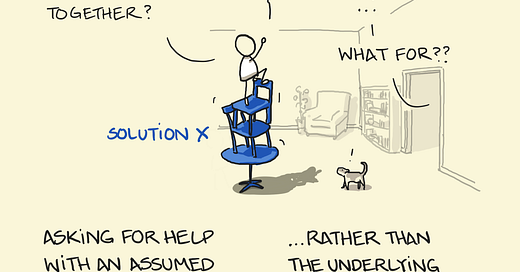Stop Asking the Wrong Question: How the XY Problem is Derailing Your Success
The XY problem has been around probably forever. It even has its own website. It is just human nature to ask dumb questions while assuming something—usually something wrong.
Let me borrow the definition from the website I already mentioned real quick because I wouldn’t come up with anything better:
The XY problem is asking about your attempted solution rather than your actual problem. This leads to enormous amounts of wasted time and energy, both on the part of people asking for help, and on the part of those providing help.
User wants to do X.
User doesn't know how to do X, but thinks they can fumble their way to a solution if they can just manage to do Y.
User doesn't know how to do Y either.
User asks for help with Y.
Others try to help user with Y, but are confused because Y seems like a strange problem to want to solve.
After much interaction and wasted time, it finally becomes clear that the user really wants help with X, and that Y wasn't even a suitable solution for X.
The problem occurs when people get stuck on what they believe is the solution and are unable step back and explain the issue in full.
We usually speak of this problem in the context of customer service, help desks, or software engineering. That’s just because these places are basically magnets for wrong questions. The fact is that this happens everywhere in life, and it might be the reason why you slow yourself and others down more often than you might want to admit.
The Era of Asking Questions
I think we all have a pretty good idea about what this problem causes when talking to another human being. But imagine talking to a computer! I like to say that we’ve reached the era of asking questions, and there is no going back.
Whoopi Goldberg would maybe disagree, but chatting with unliving entities has never been easier thanks to our brand new shiny AI agents. Agents that we nowadays overuse for daily tasks ranging from drafting an email to creating a meal plan to solving more-or-less trivial problems we face.
The problem here is that they won’t think about your request very deeply. While a person would probably raise an eyebrow and say “Well, Jessica, what a weird question! What are you trying to accomplish?”, an AI agent will happily answer all your vague questions and derail you even further, as that’s all they know. Aha! And you suddenly find yourself in a loop of “No, not that.” and “This is not what I need, try again.” and “Bad robot, let me do it myself.”
Believe it or not, it would probably help you more if you asked what are the most common causes for dying orchids in your climate, and how to identify and prevent them than “What parts do I need to build a machine that waters my orchids every four hours?”
If you told me five years ago that we would soon start writing articles explaining how to talk to computers, I would believe you, but I would ask questions. As should you!
How To Avoid It
This problem applies to any type of verbal interaction we find ourselves in. Whether it’s a customer support conversion, an office exchange, or a chat with your favorite GPT. This simple change might even make you a slightly better manager, for example.
It all begins with a shift in how you frame your questions.
Step Back and Assess
Before asking for help, pause to evaluate whether your attempted solution (Y) is indeed the best approach.
Ask yourself: “What is the real problem I’m trying to solve?”
Provide Full Context
When seeking advice, clearly describe both the symptoms (Y) and the underlying issue (X).
Offer background information that explains why you chose your approach, including any constraints or previous attempts.
Encourage Dialogue
Instead of locking in on a single solution, invite others to discuss the problem broadly. Phrases like “I’m facing this challenge—here’s what I’ve tried so far” open the door for alternative perspectives.
Ask for recommendations that might challenge your current method and lead to a more effective strategy.
Reflect on Past Experiences
Think about times when you solved a problem only to have it resurface. Often, these recurring issues are a sign that the root cause was never addressed.
Use these experiences to guide how you frame your future questions.
That’s it! The XY problem may seem like a minor miscommunication at first, but its impact on productivity and problem-solving efficiency is huge. By shifting your focus from a predetermined solution to understanding the true nature of your challenge, you unlock the potential for more effective and lasting solutions.
Now go and ask all the right questions!




